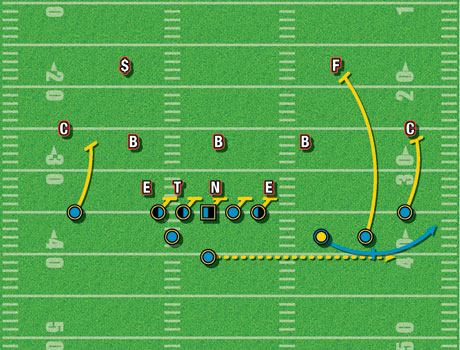When it comes to getting the ball on the perimeter to your playmakers, the bubble screen is as good as it gets. If you're a coach that charts touches to make sure you're getting your explosive players enough opportunities, this play provides a very easy method of getting the guys you want the football in space. In the past five or so years, this play has become a vital scheme in almost all spread offenses.
When to throw?
The bubble screen is generally thrown to an inside receiver that is lined up off of the ball, when the offense has a numbers advantage to a certain side on the perimeter. This play takes advantage of an outside linebacker that is cheating in the box to gain a numbers advantage in the box for the defense. In the diagram below, the offense considers themselves to have an advantage because of the outside linebacker to the trips side could still be considered an in-box defender.
Blocking:
Generally, the bubble is blocked using an outside zone, reach, or cut technique from the offensive line. The ball is out of the quarterback's hand so quickly that the offensive line's objective should just be to keep the defensive ends from shooting upfield quickly to hinder the throw or keep them from being able to run flat and possibly make a play on the ball. On the perimeter, a simple stalk technique works and the receiver can read the blocks. If it provides better angles, cracks and cross blocking can be done as well. Another way it to reach the outside shoulder of the defenders, turn them inside and have the receiver look to get up the sideline.
Receiver:
There are different techniques used to put the receiver in good position to run after the catch. I will explain the technique that we use at Liberty High School. The slot receiver (whether it is #2, #3, or #4) should align with his inside foot up and the objective on his first step is to gain more depth than width. Depth is important because we want the receiver to be catching the ball while running towards the line of scrimmage. Using the clock analogy, a good step for him would be to take his back foot to the 5 or 7 o'clock mark depending which side he is on. The receivers second step would be parallel to the line of scrimmage, and on his third step he would turn his head and look for the football while working back towards the line of scrimmage at roughly a 45 degree angle (halfway between parallel and perpendicular) to the line of scrimmage. The ball should be to him on his fourth or fifth step. In the videos below, you will see two different techniques used that are also very effective.
Quarterback:
Contrary to the tunnel screen (which will be addressed in the next post) where you see different fakes by the QB and different backfield action, the bubble does not leave a lot of room for creativity by the QB because of the ball needing to be in the hands of the receiver quickly. In the second video below, you will see some fakes to a back to get flow going away from the play and to improve the angles of the blocks. The quarterback should aim to put the football on the 12-18 inches in front of the receiver running towards the line of scrimmage.
Shotgun or Under Center?
The bubble works effectively both under center and in the shotgun. Both provide an advantage the other one does not. Under center, the ball is able to get to and out of the quarterback's hand quicker than in the gun. However, in the gun you are throwing the ball forward to the receiver instead of risking a fumble by throwing it backwards. Not completing the pass simply results in an incomplete pass instead of a backwards lateral, which is a live ball.
Videos:
In the videos below, you will see clips of the bubble screen at both the high school and the college level. Many of the coaching points discussed above can be seen, however these teams do some different things as well.
Thanks to Brethren Christian High School in Huntington Beach, CA for the video of their bubble screen game.
My alma mater, the University of Missouri also utilizes the bubble screen as a big part of their offense. The video below has several clips of their bubble screen in their bowl game vs. Navy.
Further and complete reading on the bubble screen:
Robert E. Lee High School(TX) Bubble Screen Passing Package
Also, don't forget to check out Chiefpigskin.com for tons of useful material to help promote our great profession.
Subscribe to:
Post Comments (Atom)


This is a very good blog my friend. In Chile, people usually do not practice this kind of sport due to it is not well known, but people usually play rugby because this sport is common here in Chile. My partner and I are studying Pedagogy in Physical Education, and we think that is very interesting knowing about this sport, which is so famous and popular in the United States of America. Thanks to your blog I can teach to my students the basic concepts of American football through videos and images. This help to understand in a better way what football is.
ReplyDeleteWe consider that you have to go deeper in this topic, due to the fact that your information is very helpful for people who do not have any idea of rules and concepts of this sport and maybe if they have a previous knowledge of this game they can practice it in any place of the world.
Thank you so much for your information. Greetings from Chile
Jorge Toro and Luis Poblete.